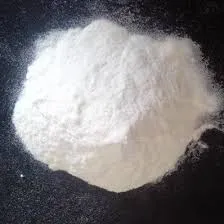
Dec . 12, 2024 11:40 Back to list
hydroxypropyl methyl cellulose ether
Hydroxypropyl Methyl Cellulose Ether Properties, Applications, and Benefits
Hydroxypropyl Methyl Cellulose Ether (HPMC) is a versatile chemical compound that finds widespread use across various industries due to its unique properties. It is a non-ionic, water-soluble polymer derived from cellulose, which is a natural polymer obtained from plant cell walls. The modification of cellulose through the introduction of hydroxypropyl and methyl groups allows HPMC to possess improved solubility and functionality, making it an essential ingredient in numerous applications.
Properties of HPMC
One of the most notable properties of HPMC is its excellent water solubility, which can be manipulated based on the degree of substitution of hydroxypropyl and methyl groups. This solubility offers flexibility in formulating different products, ranging from thick pastes to clear viscous solutions. HPMC also exhibits thermoreversible gelation properties, meaning it can change its state based on temperature, allowing it to be utilized in formulations that require temperature-sensitive behavior.
Additionally, HPMC is known for its high film-forming capacity, making it an excellent candidate for coatings and finishing processes. When dried, HPMC forms a transparent, flexible film, which is beneficial in applications that require protection against moisture and other environmental factors. Furthermore, HPMC possesses exceptional stability over a wide range of pH levels, adding to its appeal in various formulations.
Applications of HPMC
HPMC's versatility opens the door to numerous applications, particularly in the food, pharmaceutical, and construction industries.
1. Food Industry In the food sector, HPMC serves multiple purposes. It is commonly used as a thickening agent, emulsifier, and stabilizer in various food products. For instance, it is often found in sauces, dressings, and bakery products to improve texture and mouthfeel. Its functional properties contribute to extending shelf life while ensuring product consistency.
hydroxypropyl methyl cellulose ether

2. Pharmaceutical Industry HPMC is a critical ingredient in the pharmaceutical sector, where it is used as a binder and coating agent in tablet formulations. Its water-retentive properties assist in controlling the release of active pharmaceutical ingredients, thus enhancing their bioavailability. Additionally, HPMC is employed in the formulation of ointments and gels due to its ability to form stable emulsions.
3. Construction Industry In construction, HPMC is utilized as an additive in cement and mortars. It enhances workability, improves adhesion, and increases water retention, making it crucial for various building materials. HPMC-modified solutions provide better performance in plastering and tiling applications, contributing to durability and longevity.
Benefits of Using HPMC
The use of Hydroxypropyl Methyl Cellulose Ether offers numerous benefits across its applications. Firstly, its non-toxic and biodegradable nature aligns with the growing demand for sustainable and environmentally friendly products. As consumer awareness regarding health and the environment continues to rise, HPMC presents a favorable alternative that does not compromise function.
Another significant advantage of HPMC is its ability to improve the stability and viscosity of formulations without adversely affecting taste or sensory attributes. This feature is particularly essential in the food and pharmaceutical industries, where consumer expectations and regulatory standards are high.
Moreover, the controlled release properties of HPMC in pharmaceutical formulations enable precise dosing, leading to enhanced therapeutic efficacy. This capability is increasingly important in modern medication regimens, where personalized treatment plans are becoming more common.
Conclusion
Hydroxypropyl Methyl Cellulose Ether stands out as a multifunctional additive with diverse applications across various industries. Its unique properties, including solubility, film-forming ability, and stability, make it indispensable in food, pharmaceuticals, and construction. As the demand for sustainable and effective materials continues to grow, HPMC will likely play an increasingly significant role in developing innovative products that meet consumer needs while contributing to environmental preservation. With ongoing research and advancements, the full potential of HPMC is yet to be fully realized, paving the way for future applications and improvements in existing formulations.
-
Versatile Hpmc Uses in Different Industries
NewsJun.19,2025
-
Redispersible Powder's Role in Enhancing Durability of Construction Products
NewsJun.19,2025
-
Hydroxyethyl Cellulose Applications Driving Green Industrial Processes
NewsJun.19,2025
-
Exploring Different Redispersible Polymer Powder
NewsJun.19,2025
-
Choosing the Right Mortar Bonding Agent
NewsJun.19,2025
-
Applications and Significance of China Hpmc in Modern Industries
NewsJun.19,2025







